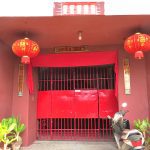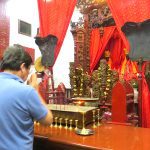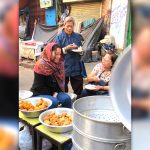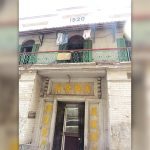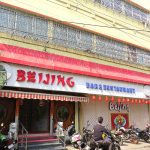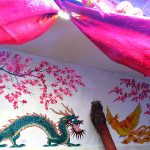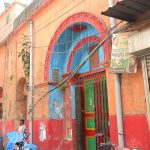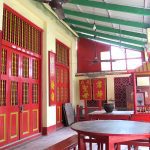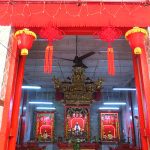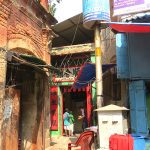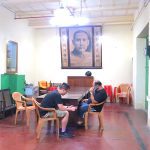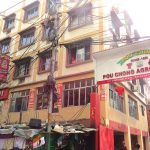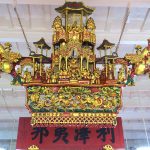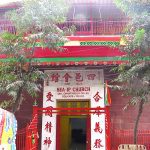
- Home
- India
- World
- Premium
- THE FEDERAL SPECIAL
- Analysis
- States
- Perspective
- Videos
- Sports
- Education
- Entertainment
- Elections
- Features
- Health
- Business
- Series
- In memoriam: Sheikh Mujibur Rahman
- Bishnoi's Men
- NEET TANGLE
- Economy Series
- Earth Day
- Kashmir’s Frozen Turbulence
- India@75
- The legend of Ramjanmabhoomi
- Liberalisation@30
- How to tame a dragon
- Celebrating biodiversity
- Farm Matters
- 50 days of solitude
- Bringing Migrants Home
- Budget 2020
- Jharkhand Votes
- The Federal Investigates
- The Federal Impact
- Vanishing Sand
- Gandhi @ 150
- Andhra Today
- Field report
- Operation Gulmarg
- Pandemic @1 Mn in India
- The Federal Year-End
- The Zero Year
- Science
- Brand studio
- Newsletter
- Elections 2024
- Events
- Home
- IndiaIndia
- World
- Analysis
- StatesStates
- PerspectivePerspective
- VideosVideos
- Sports
- Education
- Entertainment
- ElectionsElections
- Features
- Health
- BusinessBusiness
- Premium
- Loading...
Premium - Events
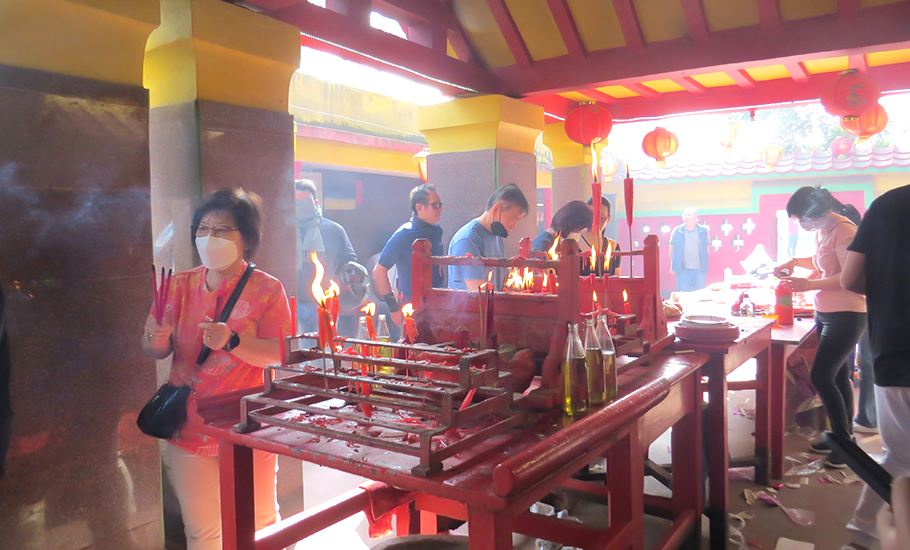
Why China is silently exiting Kolkata

The exit through Gate 5 of Central Metro station leads you out on to a street that looks no different from the rest of north Kolkata — a choked carriageway, encroached pavements, and handcarts and pushcarts jostling for what’s left of pedestrian space. Negotiating your way through this hustle and bustle, you may still catch a glimpse of both sides of the road, a couple of signboards may...
The exit through Gate 5 of Central Metro station leads you out on to a street that looks no different from the rest of north Kolkata — a choked carriageway, encroached pavements, and handcarts and pushcarts jostling for what’s left of pedestrian space. Negotiating your way through this hustle and bustle, you may still catch a glimpse of both sides of the road, a couple of signboards may pique interest — Sing Cheung to the left and Pou Chong to the right.
The Chinese letters and motifs proudly displayed on the signboards are the first indication that you are not in just any other para of Kolkata. They are part of a 250-year-old legacy — or rather, what’s now left of it. Kolkata is one of the few places in the world to have not one but two Chinatowns — locally called ‘Cheenapara’ — and the only one in India to have any at all.
If you are new to the city, you may have trouble figuring out why a couple of Chinese condiment stores would justify the title of ‘China Town’ bestowed upon this part of the city.
But there are more Chinese imprints on Kolkata as one goes ahead. An impressive red-brick structure of Toong On Church about 100 metres from Sing Cheung is one among the many signs of Chinese influence on Kolkata. The entrance to the church remains obscured by mounds of garbage and a row of parked cars, with piles of clothes and even shoes drying on its iron railings. The door remains shut most of the time, and it’s not easy to get an opportunity to set eyes on the black-and-gold Buddha statue inside.
Another few paces and you reach the 118-year-old Sea Ip Church, similarly struggling to breathe in the melee of squatters and filth. The actual shrine — dedicated to Goddess Kwan Yin — is on the first floor, while the ground floor serves as a club for community members. Interestingly, all the Chinese shrines of Old China Town — as this part of north Kolkata’s Tiretti Bazaar area is called — are termed ‘churches’ even though they are all Taoist temples. And these account for much of what the Chinese community in Kolkata has managed to cling on to as its heritage.
Fight for survival
Across the road, the Blackburn Lane leads you towards the belly of Old China Town, with a brightly painted red building drawing immediate attention. It houses the Sei Vui Church, the Sei Vui Club community hall, and the Sei Vui Restaurant, which was started in 2017 by All-India Chinese Association president Chen Yao Hua as a desperate measure to raise funds to maintain their built heritage. Chen repaired an old dormitory and turned it into the restaurant, which started doing well only last year after suffering for two years because of the covid pandemic.

“We are definitely trying to preserve Old Chinatown. But we need funds to run the temples, cemeteries, and other buildings. The temples are run with money donated by our community members. I even end up spending from my pocket. But all of it is enough for only a year. We are struggling,” admits Chen, who has been the president of the association for more than 35 years for want of a suitable successor. The number of members has dwindled to only around 30 and the Chinese community in Kolkata to around 2,000.
The community has never asked for any help from the government fearing a loss of control over all its private property, says Chen. He admits that when he took charge as the president, he hardly knew anything about the Sei Vui Club, the temple, or its history. He had no idea, for instance, that the signboard hanging outside the community hall bears the signature of a famed Chinese monk. He claims he knew about it only when a Chinese tourist told him.
Lost in the crowd
Inside Sei Vui temple, there are several deities — Chinese warrior god Kuan Ti, a god of machinery like Vishwakarma, a goddess of wealth like Lakshmi, Chen explains. The ‘idols’ are essentially metal plaques with inscriptions stating their identity. Chen haltingly reads the inscriptions to figure out, for the first time, that there are multiple sets of the same deities. He guesses that they were brought in when they lost their homes, that is, the shrines dedicated to them. And then, there are a couple of statues of ‘monks’, but he has no idea about their identity.
Deeper into Blackburn Lane, lost in the sea of meat shops and other Muslim-run small businesses, are two more Chinese temples. The Choonghee Dhonc Thien Haue Church is in a sorry state, with the paint peeling off and patches of cement showing periodic repair work on the ground floor. The main shrine on the first floor looks well maintained, though.
Farther inside is the Nam Soon Church, its entrance sandwiched between two crumbling buildings, the compound not only houses the temple but also a small school.
In between these temples, there are scattered buildings bearing Chinese inscriptions. You may also run into a Chinese face now and then in the predominantly Muslim neighbourhood. And that is about where the Chineseness of Old Chinatown ends today.
But things were very different about six decades ago, when an 8000-to 10,000-strong vibrant Chinese community called Kolkata its home.
All that began to change when 1962 happened.
The war
The Sino-Indian War took a toll on the Indo-Chinese community from which it never fully recovered — more so because the tension between the neighbours has continued. Many of the community members, including Chen’s father and grandfather, held Chinese passports. Luckily, his grandfather worked as an interpreter for the government, because of which the family got spared. But many community members were sent off to Rajasthan’s Deoli camp — in their words, the ‘concentration camp’.
And that is when the community started leaving. Shortly after the war ended, shiploads of Indian Chinese left for their original homeland. Those who stayed back found that they had little to survive on. “My father lost his job as a fitter at the Kidderpore dock. Since the port is a sensitive place, the government did not grant him a work permit,” Chen tells The Federal.
“We had no money. I could not even continue my studies,” says Chen, who now works as an interior decorator. His father finally found a job as a cook at the Japanese consulate, prompting Chen to start earning at an early age.
Pushed out of everywhere
The stories are similar for a lot of community members. At the Sea Ip Club, John Wu says many Chinese workers were employed at the tea gardens of north Bengal and as fitters at the Garden Reach shipbuilding yard or at the port. All of them lost their jobs during the war.
Also, cheaper Indian labour gradually pushed the skilled Chinese carpenters out of business, says Wu, who himself worked as one. The same thing happened with the shoe business. Even in the first half of the past century, Chinese shoemakers in Kolkata were famed for their craft. But the businesses started shutting down as more and more Indians joined the industry.
Many of them saw an opportunity in the mushrooming Chinese restaurants and entered the business as chefs. “But now, the so-called Chinese restaurants are being run by Indian-origin people, who hire Indian chefs,” says Wu, whose son works as a cook — ironically, in an Indian restaurant. Even the Chinese breakfast, for which Tiretti Bazaar is famous, is hardly ‘Chinese’ anymore, with more and more Indian faces replacing Chinese ones behind the food stalls.
Among those who left the city ages ago seeking better prospects is Lawrence Sein. Now 60, he left home 30 years ago to work as a chef in Macau. But his wife and son stayed back. His son is now a hotel management student in the city. Though he speaks Cantonese even at home, his wife and son don’t speak it too well, he admits.
But every year, Sein makes it a point to be in his hometown on one occasion — during the Chinese New Year. And that is what continues to bind Kolkata’s Chinese community to its roots. Not only are lion dances and other festivities held in both Old and New Chinatowns, every Sunday following Chinese New Year, community members make a pilgrimage to Achipur, a non-descript village in South 24-Parganas district, around 30 km from Kolkata. Because that is where it all began.
The ‘Cheeni’ who brought ‘chini’
Research suggests that the earliest immigration from China to Kolkata (then Calcutta) dates back to 1778, with the arrival of Yang Dazhao (or Tong Atchew) from Canton. He came to set up a sugar manufacturing unit and was granted land near Budge Budge port, 33 km from Calcutta. The place took its name from Atchew to gradually turn into Achipur.
It is often believed that the Indian word ‘chini’ for sugar came from the same word for the Chinese because it was the Chinese, notably Atchew, who brought refined sugar to India. According to ‘Global Chinese Migration in Geographical Perspective: a Kolkata (Calcutta) Case Study’ by Kunaljeet Roy and Sukla Basu, published in SN Social Sciences journal, Atchew’s arrival marked “the beginning of Chinese economic entrepreneurship” in Calcutta.
After that, the Chinese immigrants came in waves. The Cantonese, who settled in Tiretti Bazaar, were mostly carpenters and furniture makers — a profession they have maintained down the generations. The Cantonese were followed by the Hakka — the name literally translating to “guest people” because the Hakka have no province to call their home. They saw an opportunity in leather tanning and shoe manufacturing, which, according to the Hindu caste system, are the “occupations of the untouchables”.
The second China Town
According to Roy and Basu, the Hakka community mainly migrated from Guangdong province in China. “Those Hakkas dealing with leather materials [considered polluted as per Hindu beliefs] had no other option but to stay away from the populous core of the city and migrate to (the) marshy vacant outskirts thus forming the second China Town of Kolkata at Tangra (Dhapa) area.”
They were not the only ones. Those from Hubei province were renowned as dentists, while those from Shanghai and Jiangsu provinces specialised as dry cleaners. But all that is now history. As the city expanded, the once-outskirts of Tangra became city proper, and at the turn of the millennium, the tanneries of Tangra came to a grinding halt as the Supreme Court directed that the polluting units had to go.
Today, Tangra’s ‘New China Town’ looks just as undeserving of its title as Tiretti’s Old China Town. Chinese motifs on random houses in the narrow alleyways, a couple of temples that look nothing like temples, closed tanneries, and a Chinese restaurant every few metres are what is left of its Chineseness. The restaurants are what draw Kolkatans as well as tourists to Tangra today.
And, there is also a Chinese Kali Temple, with Chinese dragons painted on the ceiling and Chinese lanterns hanging at the door. Many Chinese pray at the temple with just as much reverence as they do at one of the Taoist temples. Interestingly, many of them are baptised Christians.
‘Strength became weakness’
One of the many tannery owners whose units were shut down is 79-year-old Chen Liang. Standing outside his closed tannery, he blames his own community “100 per cent” for being on the verge of extinction in the city today.
“We were born here, we are getting old here, and we can’t even speak Hindi properly. For the leather industry, we brought in people from Punjab and Bihar, but did not hire local Bengalis. We speak ‘dehati Hindi’ with them and Hakka Chinese at home. We remained cooped up in the leather industry, hotel industry. There is not a single Chinese-origin person working in the government even though we are Indian citizens, we have Indian passports,” he points out.
According to Liang, the very professions the Chinese community once saw as its strength became its doom because they “did not want to venture out”. And then, Indians started entering those very industries they once wanted to avoid. Both of Liang’s children are now settled abroad.
The legacy
Intriguingly, the best place to witness the ‘Chineseness’ of Kolkata’s Chinese community is still the sleepy village of Achipur, which comes alive during the Chinese New Year. Many members of the community, for whom New Year is the time for homecoming, make it a point to visit Achipur to pray at Atchew’s tomb and what the local auto driver calls the Cheena Mata Mandir.
Some say the small Chinese temple in Achipur — dedicated to the Earth God and Earth Mother — was built by Atchew himself, though it is debated. But it remains holy to the community, who visit the temple in large numbers over three Sundays following the New Year. They light thick Chinese incense sticks and offer holy handmade papers at the temple and at Atchew’s tomb, about a kilometre from the temple.
Even youngsters, who are more accustomed to Indian ways, diligently perform this annual pilgrimage. Among them are Stephanie Li (29) and her brother Henry (25), who are taking Chinese food products such as chips and sauces to the rest of India through their startup called So Asean.
Identity crisis
The Li family came to Kolkata over 100 years ago. Born and brought up in Kolkata, Stephanie says, “I’m Chinese by roots, but I’m an Indian at heart. I don’t think if I go to China, I can stay there. I’m too used to Indian food, Indian environment. And it is the same for my family. For most of the Chinese people you see here, no matter where they go in the world, they do come back to their hometown, Kolkata.”
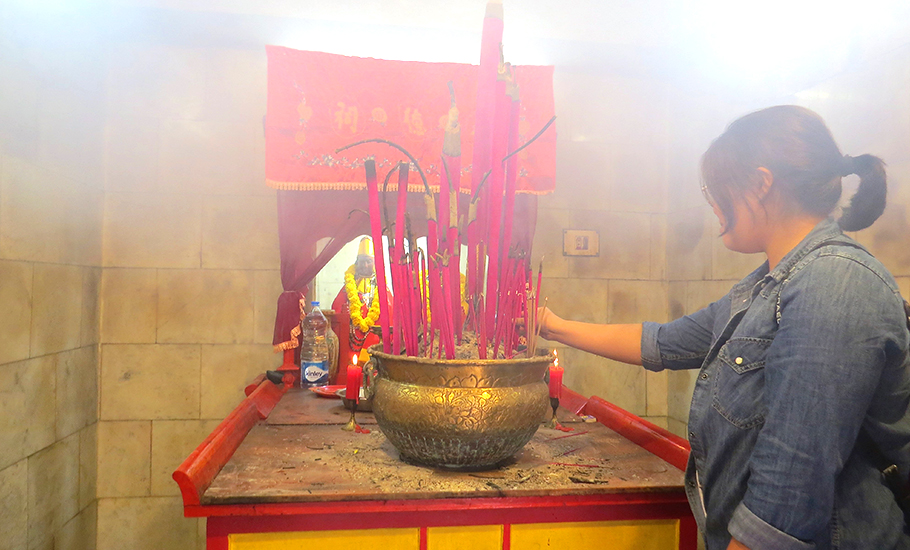
At home, they speak a mix of Hakka, Hindi, and English. But the share of Hakka is now down to only about 10 per cent, admits Henry. “We are not extremely Chinese to be called Chinese, but not Indian enough to be called Indian either. We are somewhere in between. If we go towards the Indian community, we aren’t accepted as Indian even though we speak Hindi, have Indian passports. But if we go to the Chinese community, we are Indian for them,” shares Henry, sitting by the Hooghly (Ganga) that flows past Atchew’s red, horseshoe-shaped tomb.
“We are not recognised as a community in India. We are neither a minority nor mainstream. The reason why the Chinese community is dwindling in India is because we have nothing to call our own. Secondly, everything is being encroached upon,” he says.
A dying culture
Some fear that what remains of the Chinese culture too may die soon.
“The culture will eventually die because whatever is left of the Chinese community is being grabbed by real estate agents. We are a small community. Back in Kolkata, we have Chinese temples, schools, but now we fear even these may not remain. This path [leading to Atchew’s tomb] used to be much broader [A section has caved in as well]. In Tangra, people are eyeing very old properties. This heritage may be very difficult to preserve,” says Stephanie, Henry’s sister.
Henry is also one of the organisers of the annual Dragon Boat Festival in Tangra, where Rabindrasangeet is sung with the same gusto as a Chinese song. But it’s getting tougher by the day as younger community members keep leaving for more cosmopolitan destinations such as Australia, Canada, or Singapore.
The number of lion dance groups in Tiretti is now down to one. “Even if we try to do something, it’s not enough to stop people from leaving,” says Henry.
“There needs to be a reason for us to stay. We need to feel at home,” he says before getting up to offer his prayers to the man who has kept Kolkata’s Chinese community tied to its roots even 250 years after his death.

